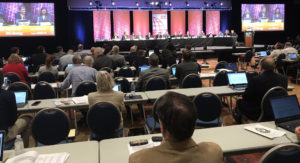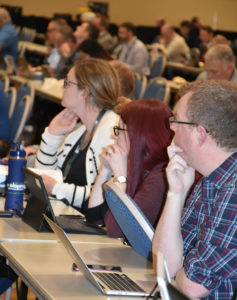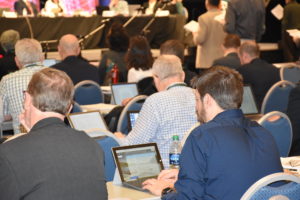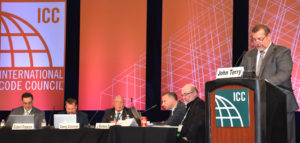
Big takeaways from the Committee Action Hearings
 The 2019 Committee Action Hearings took place April 28 through May 8, 2019, in Albuquerque, N.M., to consider proposed changes to the Group B International Codes. The second in the 2021 code development cycle, the hearings saw action on more than 1,300 code change proposals and nearly 185 hours of testimony in two hearing tracks during the 11 days in Albuquerque.
The 2019 Committee Action Hearings took place April 28 through May 8, 2019, in Albuquerque, N.M., to consider proposed changes to the Group B International Codes. The second in the 2021 code development cycle, the hearings saw action on more than 1,300 code change proposals and nearly 185 hours of testimony in two hearing tracks during the 11 days in Albuquerque.
The International Codes are a family of 15 coordinated, modern building safety codes used throughout the world that protect against disasters like fires, weather-related events and structural collapse. The Group B Codes considered in Albuquerque include the International Building Code (structural provisions), International Existing Building Code, International Energy Conservation Code (commercial and residential energy provisions), International Green Construction Code (Chapter 1), and International Residential Code (building and energy provisions) as well as Chapter 1 (Administration) of all the International Codes (except the International Energy Conservation Code, International Green Construction Code and International Residential Code) and the update of currently referenced standards in all of the 2018 International Codes (except the International Green Construction Code).
Here are some of the biggest takeaways from the 2019 Committee Action Hearings.
Highlights from the IBC–Structural Committee
-
 Over the course of the Group B Committee Action Hearings, the 15-person IBC–Structural Committee heard 281 code change proposals (114 were voted As Submitted, 68 As Modified, 98 Disapproved and one was Withdrawn).
Over the course of the Group B Committee Action Hearings, the 15-person IBC–Structural Committee heard 281 code change proposals (114 were voted As Submitted, 68 As Modified, 98 Disapproved and one was Withdrawn).- The diverse code change proposals included significant proposed changes to coordinate and update the International Building Code with the latest American Society of Civil Engineers (ASCE) standards.
- The list of structural code change proposals included numerous proposals to update the International Building Code with the latest American Concrete Institute (ACI) standards; including the new ACI 318–19, which is the first international standard to adopt the latest in quasi-brittle fracture mechanics for the size effect in concrete design.
Highlights from the IRC–Building Committee
The following are proposals that were recommended for Approval as Submitted or Approval as Modified by the IRC–Building Committee.
-
- RB35 and RB36 — Coordinate the wind design criteria in the International Residential Code with the 2016 edition of ASCE 7. The ASCE7–16 wind maps include many areas of the country where wind speeds decreased below the speeds of previous maps.
- RB40 — Provides prescriptive requirements for light-frame dwellings on steep hillsides.
- RB199 — Locations and offsets of braced wall lines were clarified.
Highlights from the Administrative Code Development Committee
-
- A revision of the alternative materials, design and methods of construction and equipment existing section in the International Building Code that improves the layout and clarity of the requirements — ADM19–19 — was Approved As Modified.
- The addition of a performance-based application appendix to the International Building Code — ADM44–19 — was Approved As Submitted.
- An update of the International Code reference standard editions — ADM47–19 — was Approved As Modified.
Highlights from the IEBC Committee
-
 Storm shelters. There were several proposals affecting the storm shelter requirements. Of particular note were EB108–19 that clarified that storm shelters were only intended to address students and staff not the general public. Proposal EB109–19 removed the 1,000-foot distance to a storm shelter as the limitation can be problematic and cause overcrowding. Also, proposal EB14–19 moved the storm shelter requirements to Chapter 3 to apply to all methods.
Storm shelters. There were several proposals affecting the storm shelter requirements. Of particular note were EB108–19 that clarified that storm shelters were only intended to address students and staff not the general public. Proposal EB109–19 removed the 1,000-foot distance to a storm shelter as the limitation can be problematic and cause overcrowding. Also, proposal EB14–19 moved the storm shelter requirements to Chapter 3 to apply to all methods.- Smoke alarm and CO detection. Proposal EB40–19 relocates the smoke alarm and carbon monoxide (CO) provisions from the prescriptive and work areas methods to Chapter 3 of the International Existing Building Code to provide consistency amongst the methods. Also, the CO provisions were correlated with revisions in Group A to the International Fire Code and International Building Code to address the more general reference to detection (alarms or detectors) and the addition of classrooms in Group E occupancies.
- A couple highlights for accessibility include the addition of a requirement for level 3 alterations to provide two-way communication in buildings with elevator service (EB94–19) in accordance with Section 1009.8 of the International Building Code. Another key revision was proposal EB25–19 that clarifies the application of accessible features where a change of occupancy occurs. The 2010 ADA Standard do not address a change of occupancy but instead treats all alterations the same. Finally, proposal EB51–19 adds acoustic requirements for Group E classrooms in additions and level 3 alterations (work area greater than 50 percent of building).
The next phase
Here are some dates and information to keep in mind.
2019 Group B Report of Committee Action Hearing is posted
The 2019 Group B Report of Committee Action Hearing from the meeting in Albuquerque, NM are now available. Click here for the results.
2019 Group B Public Comment Hearing
The submittal of public comments for the 2019 Group B International Codes will be considered at the 2019 Group B Public Comment Hearings scheduled for Oct. 23–30, 2019, in Las Vegas, Nev.
2019 Group B Committee Action Hearing hearing videos
The over 1,300 code changes considered at the 2019 Committee Action Hearings have been captured on video. Click here to view the hearing videos.
Advocacy and the code development cycle
 The Code Council is the impartial convener of the code development process. Our job is to ensure a transparent process and to provide a space for balanced debate and deliberation on code change proposals. To that end, the Code Council has advocacy guidelines and procedures to guarantee a fair process. We rely on participants in this process to uphold themselves and their colleagues to the highest standards of professionalism and ethical behavior. To read our Code of Ethics, click here.
The Code Council is the impartial convener of the code development process. Our job is to ensure a transparent process and to provide a space for balanced debate and deliberation on code change proposals. To that end, the Code Council has advocacy guidelines and procedures to guarantee a fair process. We rely on participants in this process to uphold themselves and their colleagues to the highest standards of professionalism and ethical behavior. To read our Code of Ethics, click here.
Learn more about the code development process
The International Code Council’s code development process for the 2021 codes will take three years and is open, transparent and inclusive. To learn the basics of the code development process, check out our video, which is a good primer for those new to the process and explains ICC’s cloud-based system for the code development process — cdpACCESS — in terms everyone can understand.
For more information about the code development process, click here.
Download infographics about the process: How It Works and By the Numbers.
Click here to see photos from the 2019 Committee Action Hearings in Albuquerque.






